Why Croatia? Oyster Tasting on a Floating Island in Mali Ston (VIDEO)
April 18, 2023 - Croatia has a multitude of individual gourmet experiences, including the fabulous oyster tasting on a private floating island just off Mali Ston.
It is only a tiny place, and nearby Ston is not much bigger, but Mali Ston and its neighbour really do pack a lot into their tourist offer.
Here you can find the expansive salt works that used to generate 35% of the annual revenue for the Republic of Ragusa, as Dubrovnik used to be known, as well as what some claim as the largest fortified wall still in existence outside China - the wall was built to protect the salt.
But for foodies, there is one more reason to visit Mali Ston.
Oysters.
Mali Ston is one of the best places in Europe to sample an oyster or three, and the local restaurants have become very creative in how they present their gift from the Adriatic over the years in their menus (I thoroughly enjoy a 5-course oyster menu on my first visit). But when it comes to combining tourism with oysters, it is pretty hard to beat the unique experience of leading local restaurant, Bote Sare.
In addition to the excellent waterfront restaurant of the same name, the Bote Sare team offers an oyster boar trip to a floating island they constructed a few years ago. Here you can learn all about the oyster growing process, seeing progress of the strings of oysters hanging over the side of the floating island, before sampling a fresh batch with a fresh glass or three of local white wine.
You can check out a lot more about the experience in my article a few years ago, How to Shuck a Croatian Oyster on a Floating Bar on the Adriatic. O much better, check out this excellent video by 45 Degrees Sailing, on a recent CROMADS experience.
****
You can subscribe to the Paul Bradbury Croatia Expert YouTube channel here.
What is it like to live in Croatia? An expat for 20 years, you can follow my series, 20 Ways Croatia Changed Me in 20 Years, starting at the beginning - Business and Dalmatia.
Follow Paul Bradbury on LinkedIn.
Croatia, a Survival Kit for Foreigners is now available on Amazon in paperback and on Kindle.

Croatia Through the Eyes of a Digital Nomad: A Feast and a Festival with Oysters & Wine
March 25, 2022 - The Feast of St. Joseph meets the Festival of Oysters on Pelješac for a fun day of food, wine, and Dalmatian music.
Two years ago this month I arrived in Split, with a mission to visit to the Ston oyster festival and the town’s famous walls on top of my list. Foodies know the tradition that you should only eat wild oysters during the months that contain the letter "r" in the name – from September to April – and this time of year is peak season for fresh oysters. Even the ancient Romans who inhabited these parts followed this opinion to get their favorite aphrodisiac.
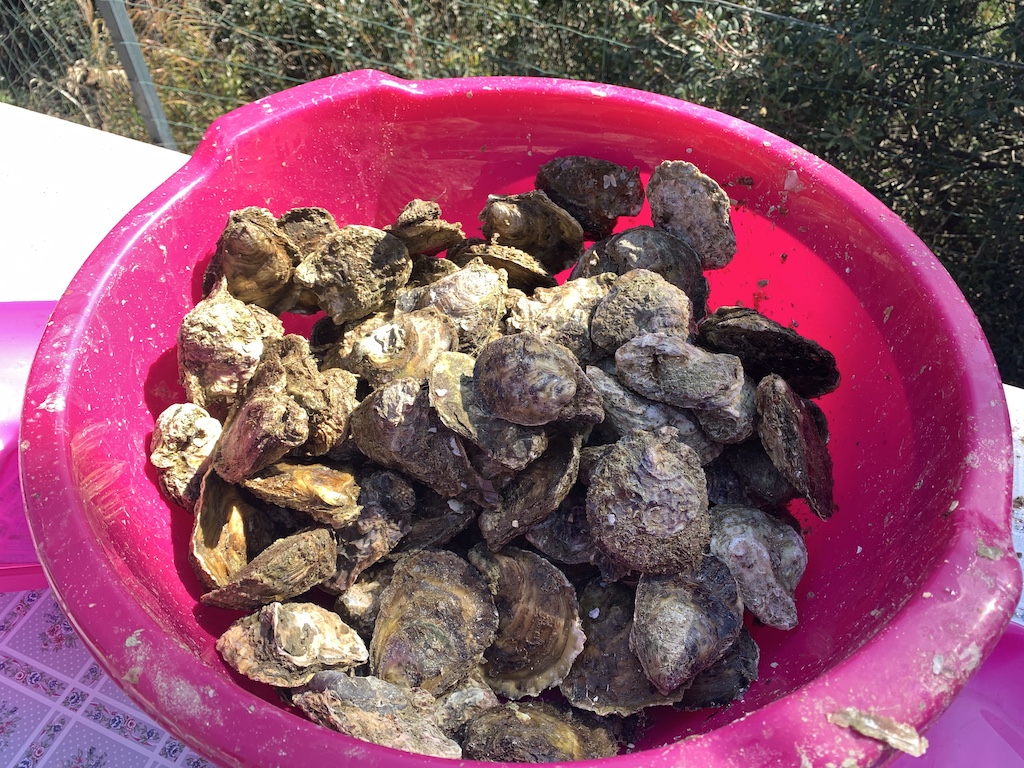 The local oysters found in Mali Ston are called European Oysters, or Ostrea Edulis.
The local oysters found in Mali Ston are called European Oysters, or Ostrea Edulis.
The festival returns
But alas, covid-19 cancelled the festival two years ago and my plans have been on hold, until now. A trip to Bistrina for the annual oyster festival in Mali Ston was a chance to both taste the shellfish this area is famous for and wash it down with vino that puts the Pelješac peninsula on any wine-lover’s radar. The funny thing is, I grew up on the Atlantic Ocean and I adore all seafood, except oysters. I was willing to give them a try in Croatia based on the reputation, but I was hoping there would be more.
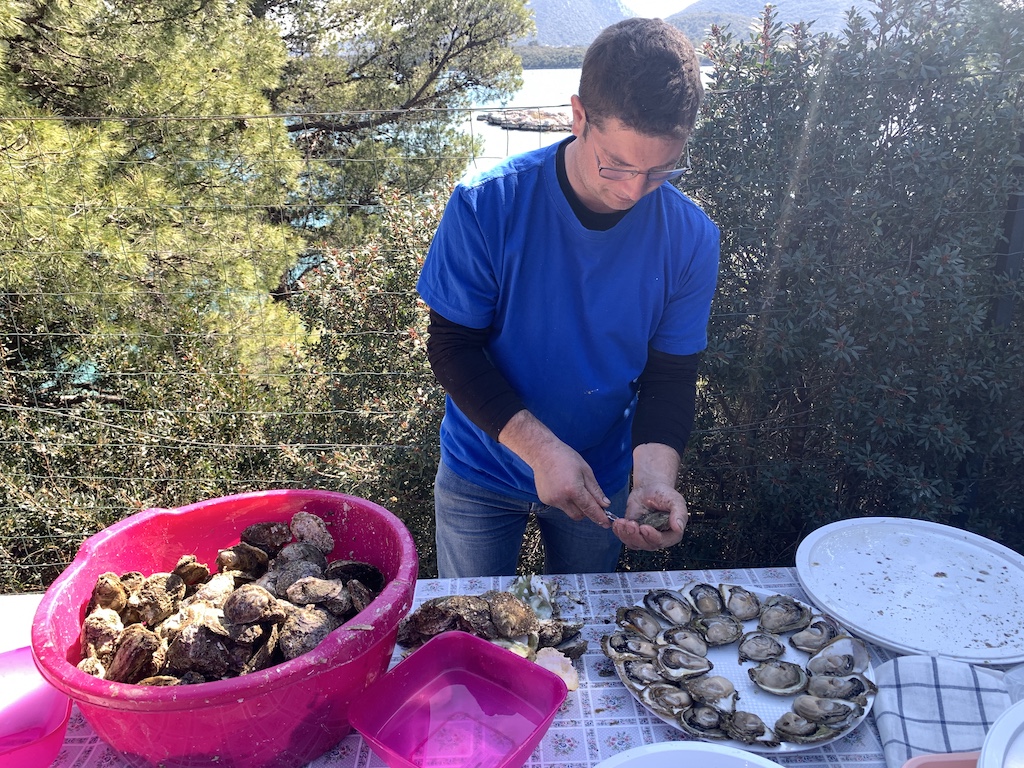 Farming and harvesting oysters in Mali Ston dates back to the Roman days of the Republic of Ragusa (1358-1808) and was a source of wealth that exceeded salt.
Farming and harvesting oysters in Mali Ston dates back to the Roman days of the Republic of Ragusa (1358-1808) and was a source of wealth that exceeded salt.
I joked with a friend that my favorite part of the festival was carrying my wine glass around on my neck, which was a first for me. It looked ridiculous but it was convenient for hands-free slurping of oysters and also more wine, lol. When it came to tasting, the best food tip I received all day was to simply squeeze lemon on the oysters and then suck them off the shell. I can’t say I tasted anything, except for the lemon juice, but it was fun.
Father’s Day
Not accidentally, the festival coincides with the Feast of St. Joseph every March 19, also called Saint Joseph’s Day. It has to do with the Feast falling during lent and abstinence from meat. This is Father’s Day in Croatia and named after Jesus’s dad. Christian heritage here believes he’s the patron saint of Croatian people and a protector of families and carpenters/workers.
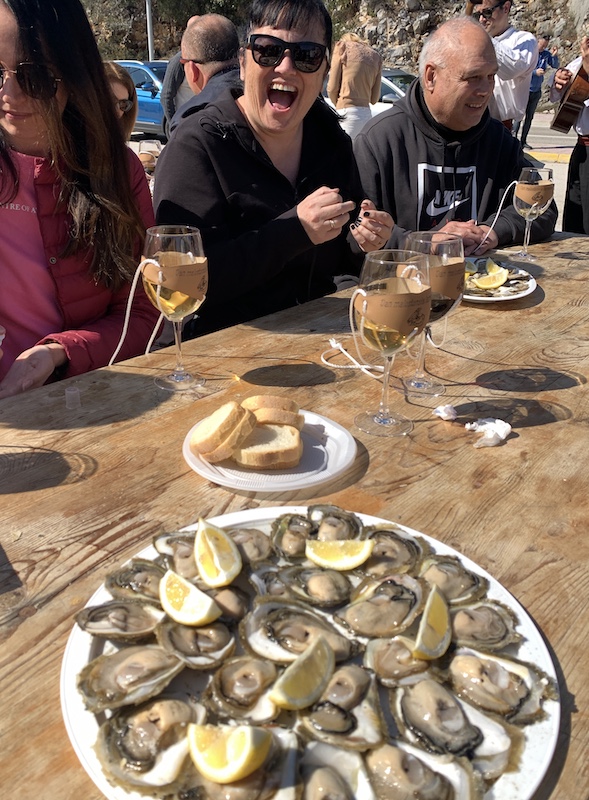 Chowing down with fellow Cromads.
Chowing down with fellow Cromads.
Cultivation techniques
Walking around Bistrina, I noticed clusters of plastic markers throughout the bay. Farmers use a system with cages and a technique of suspending oysters in the water to help them grow. To indicate how seriously people take this business, a nearby mariculture laboratory—part of the University of Dubrovnik—conducts research, testing, and quality checks on the oysters and the mussels from these beds.
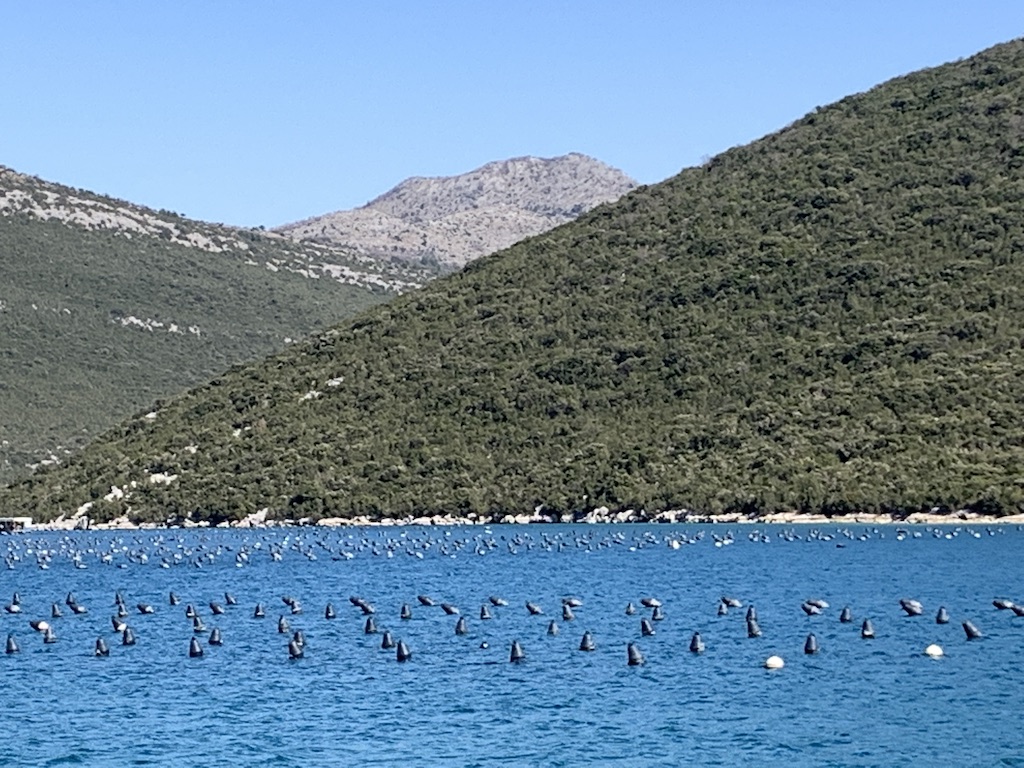 Plastic markers in the bay indicate where the oyster beds are. Minerals and phytoplankton in the salty water contribute to the high-quality of the shellfish.
Plastic markers in the bay indicate where the oyster beds are. Minerals and phytoplankton in the salty water contribute to the high-quality of the shellfish.
Cultivation dates back to the 14th century and peaked in the 1980s with 3,000 tons of mussels and two million oysters produced annually.
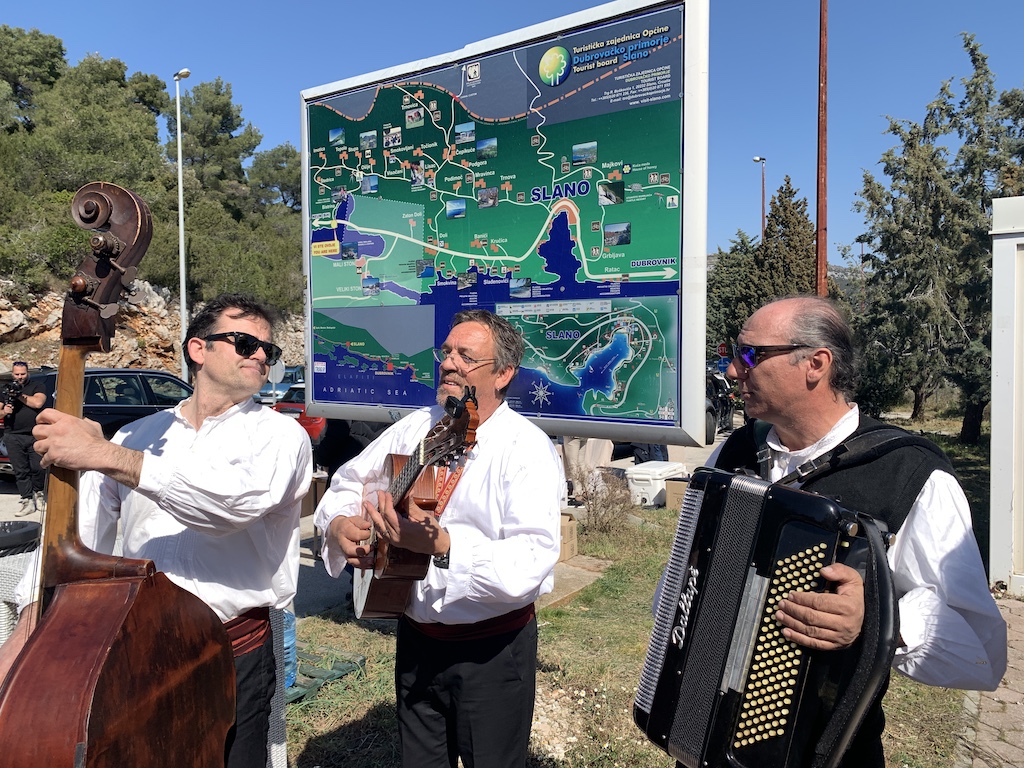 Local musicians play favorite Dalmatian tunes.
Local musicians play favorite Dalmatian tunes.
Natural sea salt, high-quality freshwater, and favorable environmental conditions are the secret sauce for producing exceptional shellfish in this area, and the corresponding wealth. Rumor has it that Roman aristocrats from the days of the Ragusan Republic were even paid in oysters instead of money. So, would they eat their money??
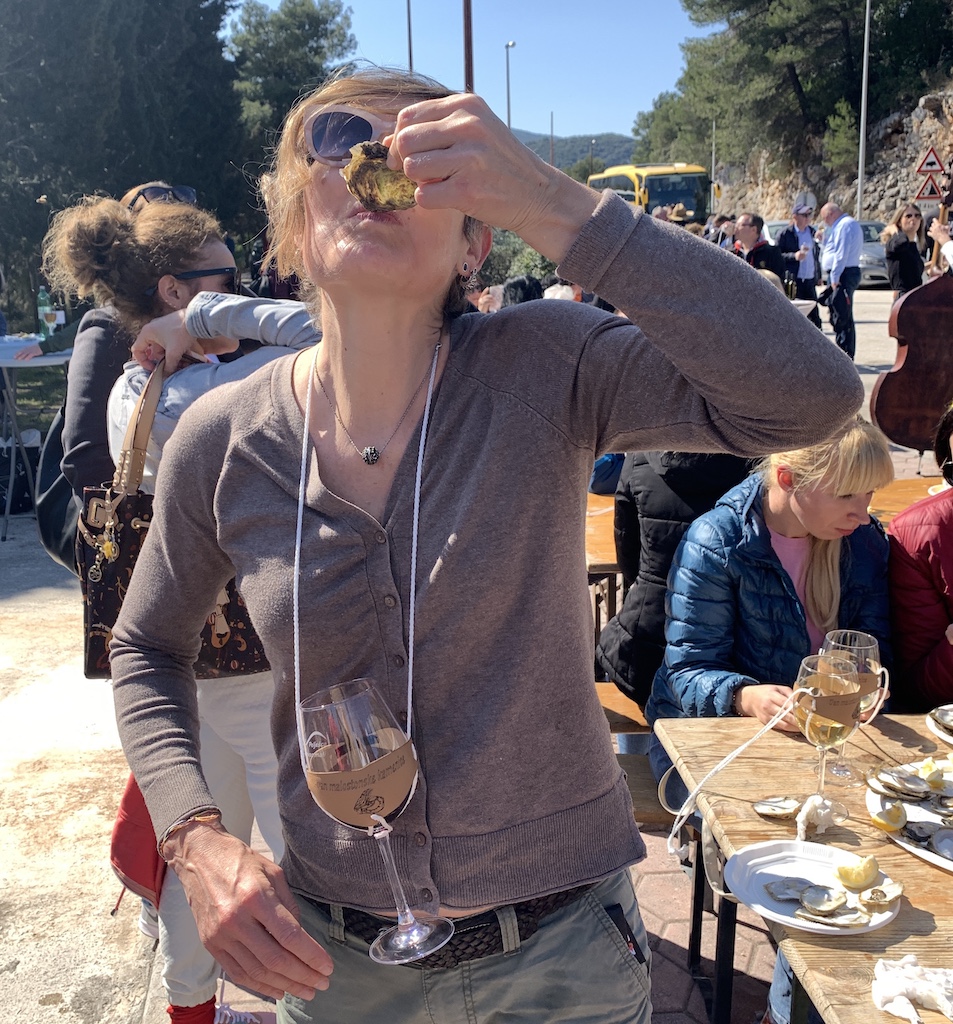 The author keeps her wine glass close to sip and slurp.
The author keeps her wine glass close to sip and slurp.
Ston saltworks
A different system exists over at Ston with an equally impressive history: the saltworks. Salt pans look like a grid dividing the surface of the water. Traditional production methods to extract salt using the sun and wind have remained the same for centuries and everything is still done by hand. Again, healthy environmental conditions are perfect for creating a superior product.
 Salt has been a source of wealth in Ston for centuries, also since the Republic of Ragusa ran things here. These saltworks are the largest in Europe.
Salt has been a source of wealth in Ston for centuries, also since the Republic of Ragusa ran things here. These saltworks are the largest in Europe.
As with the shellfish, Ston’s “white gold” dates back to the Middle Ages as a white-hot commodity. In fact, salt sparked wars and influenced trade routes. Wowza!
Rich history
The day turned out to be much more than hitting up a festival. Ston and Mali Ston have a rich history of tradition, labor, and economics in shellfish and salt, and there’s the famous Pelješac wine. The walls of Ston are another highlight as one of the largest preserved fortification systems in the world, but that’s another story. And let’s not forget the Feast and Father’s Day.
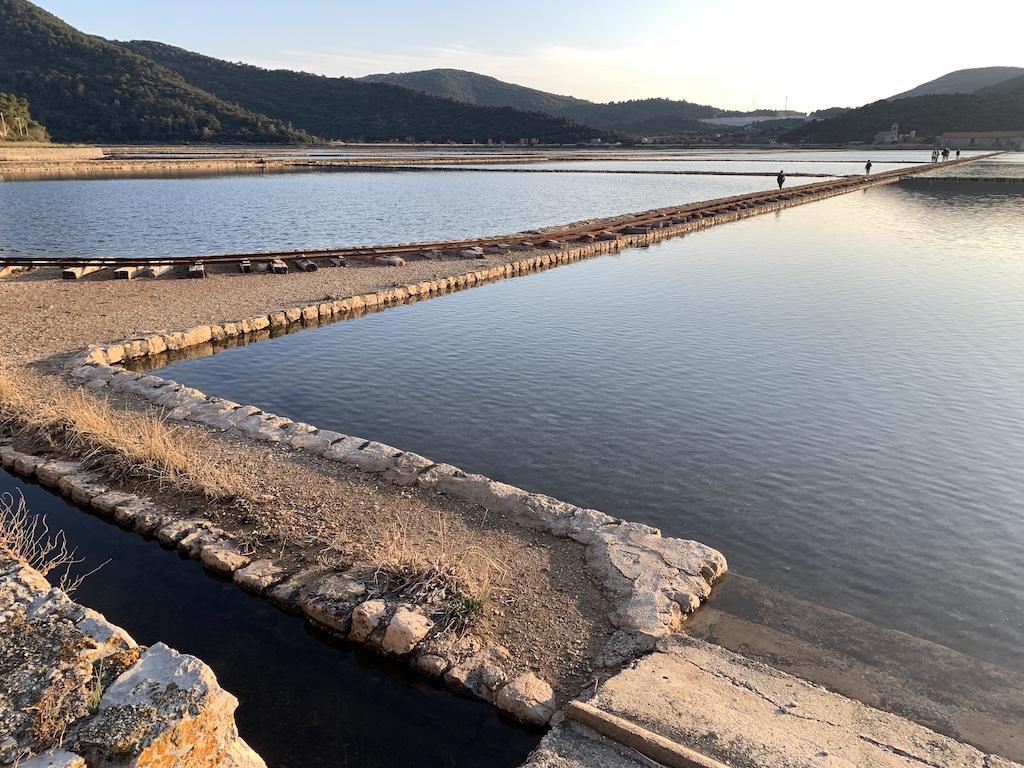 Gates are opened to let water flood into the salt pans. When the water evaporates, the salt is left behind. This process is repeated over and over and the salt is harvested once a year.
Gates are opened to let water flood into the salt pans. When the water evaporates, the salt is left behind. This process is repeated over and over and the salt is harvested once a year.
I love piecing together the cultural connections in this region. It’s one of the reasons I love to travel, for authentic experiences and learning about places that are so different from my home. As a bonus, I got to spend the day with adventurous new friends and digital nomads. The trip was organized by the Cromads travel club.
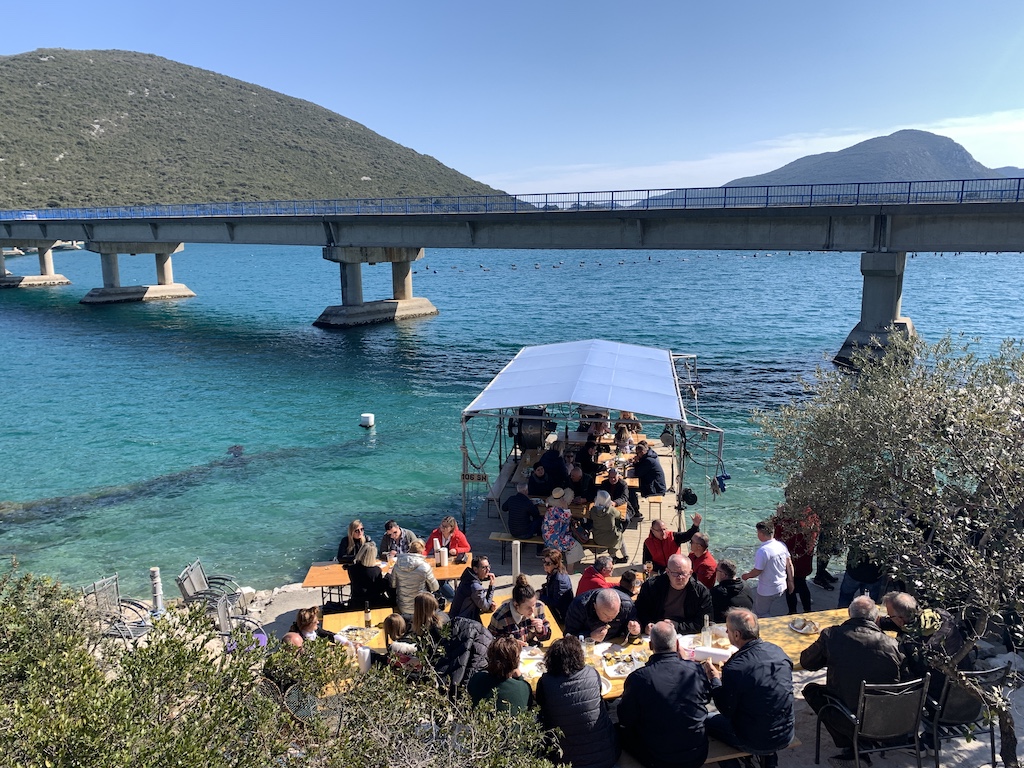 Dining on the Bistrina Bay with a beautiful view of the clear blue water.
Dining on the Bistrina Bay with a beautiful view of the clear blue water.
Story and photographs ©2022, Cyndie Burkhardt. https://photo-diaries.com
Learn more at TCN’s Digital Nomads channel.
Ston Cable Car Planned on Podzvizd Hill with EU Funds
December 28, 2021 - Is a Ston cable car in the cards to bring more visitors to the destination in the coming years? A closer look.
The 2020 budget was adopted at the Ston Municipal Council session. As a result, many projects are being prepared for the new programming period, financed from European Union funds, reports Slobodna Dalmacija.
One is the funicular, or cable car, to Podzvizd hill. The project would give Ston one of Dubrovnik's most popular tourist attractions, which earns a lot of money every year.
Local mayor Vedran Antunica (HDZ) spoke about the state of the cable car project.
"When the Podzvizd Fortress is being renovated, which has a breathtaking view, it would be good to bring it closer to our guests. However, if you have something beautiful, and it is not available to a larger number of people, then there is nothing of it," said the mayor and added:
"Recording a report on the ascent to the walls of Ston, our famous alpinist Stipe Božić once said that he had not experienced such an unforgettable view from Podzvizd, except for Ston, to the south and north side of Pelješac. His statement gave rise to the idea of our funicular.
The first condition for this project is to amend the municipal spatial plan, which should be harmonized with the county. A public debate is underway.
It is a process, from idea to realization. It takes a little more time because it is necessary to make an environmental impact study and conceptual design in addition to economic analysis.
For the reconstruction of the Podzvizd fortress, which is being done by the Society of Friends of Dubrovnik Antiquities, an archeological study and part of the project documentation have been prepared," Antunica emphasizes.
"In the spatial plan, we have defined the area, and whether it will be a cable car or a funicular on rails similar to Zagreb, we will see. The experts will decide that.
And the conservatives approved the idea in principle. One of the ideas is that the starting station should be towards Hodilj, and the descent above Mali Ston, so as not to disturb the views of Ston," said the Municipality leader.
Antunica replied that it is difficult to predict when this will come to fruition.
"We will try to apply for European funds for the project because it is a huge amount of money," the mayor said and added that other councilors have accepted this idea as good:
"This project will improve the whole area, not only to the Municipality of Ston. Who could be against that? It will also bring new jobs. If it is half as successful as Dubrovnik, it will be great."
Local councilor Slobodan Pavlović (Homeland Movement) states that "the location of the funicular towards Hodilj was missed and that it would be a waste of money because there is no view there."
"The wrong location would be a complete failure of such a project. So what is most important when building something? Location!
Why is the Dubrovnik cable car attractive? Because, when you board the cabin, you experience a beautiful view of the City while driving towards Srđ," pointed out the councilor, and concluded:
"That is the reason why tourists rush to the cable car, and not just to the top. This should happen in Ston, where on one side we would have a view of Ston, the saltworks, and Mljet, and on the other side Mali Ston, Mali Ston Bay, islands, and all the beauty in that part of our municipality."
To read more about lifestyle in Croatia, follow TCN's dedicated page.
Queen of Oysters Project Presented in Dubrovnik
30 June 2021 - The EU-funded project entitled Queen of Oysters was presented today in Dubrovnik’s Hotel Lero. The project is focused on traditional Mali Ston shellfish farming on Peljesac Peninsula.
Project coordinators Andjela and Ksenija Matic of EventLab alongside the head of the project Vedran Kunica, presented the efforts to local tour guides today. Vedran Kunica is one of Pelješac oyster farmers and a secretary of Stonski Skoljkari – Association of Ston Shellfish Farmers.
Mali Ston Oysters recently received the European Union’s protected designation of origin and protected geographical indication. This is the only instance of such a designation for this specific type of oyster. The European flat oyster (Ostrea Edulis) has been cultivated in the Bay of Mali Ston for centuries. It is one of the most delicious oysters in the world. This is one of its very last natural habitats in Europe. Locals call it the Queen of Oysters. The intent now is to turn this delicacy into a local food brand. While Mali Ston oysters might be popular on a national level, globally they are still to receive the recognition they deserve. Most guests coming to the Dubrovnik area don’t realise they are going to be staying so close to the source of such wonderful seafood.
Project Goals
The Queen of Oysters project is complex and mainly focused on marketing and promotional efforts. It started in February this year and will last for a year. Through it a new visual identity of Mali Ston oysters is envisioned. It is simple and to the point.

One of the goals of the project is communicating the information on local oysters to various stakeholders and raising awareness and consumption of oysters locally. Special workshops with restaurant owners and local chefs are a part of the efforts as well. Restaurants play a key role in the sales of Mali Ston oysters.
Various events were in the organisers' plans as well, but due to COVID-related restrictions, not all are going to happen.
When it comes to promotional efforts, the project is going very strong. There are oyster posters on Dubrovnik Airport and on city buses. Mali Ston oysters are also a part of Croatia Airlines' in-flight magazine. You will be able to see some project posters on Jadrolinija ferries during the summer as well. Local restaurants received hemp fabric promotional aprons featuring the project logo. The response from them is overwhelmingly positive.
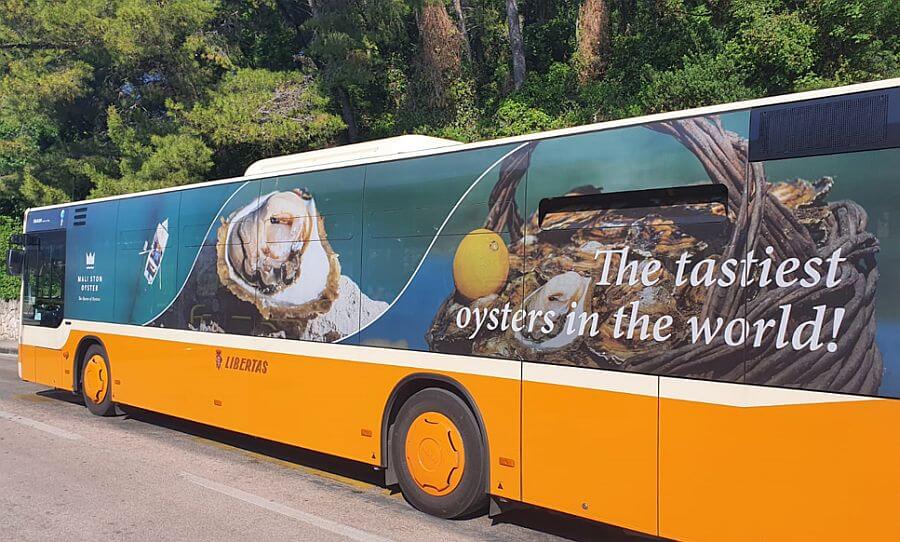
Brochures and booklets
Printed material is especially impressive. Three different booklets and flyers created through the project contain interesting information about the oysters as well and wonderful visuals. They represent a great way of raising awareness of Mali Ston oysters and the area in which they traditionally thrive. The small flyer is going to be in restaurants to inform the guests about Mali Ston Oysters. It will be at the airport as well. The design of the brochure is such as to give a bit more info on history, tradition, and oysters themselves. It also folds out into a lovely photograph. The booklet is serious informational material that contains thorough information on the oyster and the area.
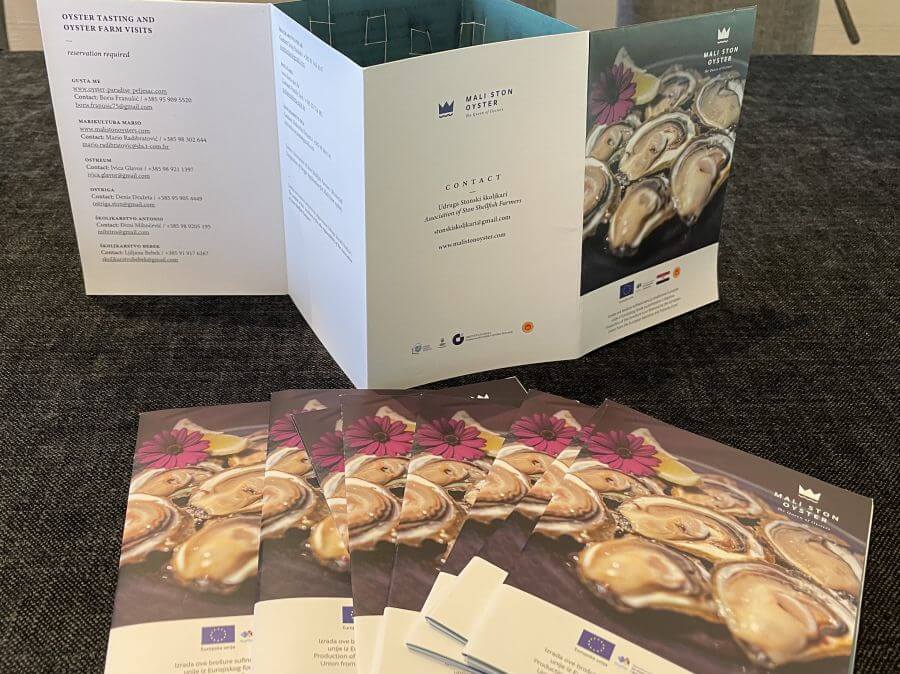
It is clear this project is the long-awaited push to brand Mali Ston oyster a bit better. Sadly, this treasure of local cuisine has spent too much time in the shadows of some other local attractions.
The presentation went off successfully with plenty of questions and suggestions from the auditorium. Also, there were some interesting ideas about how to increase sales and there was much talk about the guests and their experiences.
For more content like this follow Made in Croatia.
Mali Ston Fishers Suffer Huge Losses During COVID-19 Pandemic
March 29, 2021 - Mali Ston oysters are the best around the holiday of St. Joseph. However, due to the pandemic, Mali Ston fishers, who mainly sell oysters in restaurants, have been suffering huge losses for the second year in a row. They manage in various ways and even sell on the doorstep.
At normal times of the year, all roads lead to Ston, Vijesti.hr reports. But due to the bad epidemiological situation, Oyster Days were canceled for the second year. Instead of guests, Tomo Šare takes journalists on a voyage through the Mali Ston Bay.
This type of oyster is extraordinary as it only grows only here in the whole world. It takes 3 years to grow to consumer size; every year in May and June, that cycle begins. The oyster then drops up to a million eggs into the sea, and breeders posit collectors.
"As the sea passes through the collectors, everything catches oysters, mussels, and grass. We aim to make the oysters look like this after a year of growth," explains Tomislav Šare, caterer.
After they are removed from the collector, the so-called cementation follows. "We glue 25 oysters on one and 25 on the other to return to the sea. They grow for another two years, depending on the position as they develop", says Tomislav.
One million oysters are grown in Mali Ston Bay every year, and due to the pandemic last year, only 30 percent of the crop was placed. Shell fishers are suffering huge losses and coping, from the virtual marketplace to selling on doorsteps.
"These are negligible quantities to which we have been accustomed so far. They went to the catering facilities who prepared so much, which is now missing. There are a lot of goods left, and even if it were launched, we would not have enough for our county, let alone exports", says Marija Maškarić, president of the Stonski Školjkari Association.
With one-time assistance and monthly support for job preservation, they requested compensatory measures from the state.
"Both requests were sent for both reference periods, but to date, there is no concrete information for payments. We hope, we expect, we believe, we are promised. That would be a great help for shellfish farmers to continue production", adds Marija Maškarić.
The Mali Ston oyster recently received the European protected designation of origin. As much as half a million kuna of European funds is worth a marketing project that should help shellfish in corona crisis times.
"The product is presented as well as possible, and that actually aims to increase consumption per person to the visitor. We cannot change our county's attendance. We cannot change the structure of guests. What we can do is present our product to be sold in as large a quantity as possible", explains Vedran Kunica, project manager of the protection of Mali Ston oysters.
Instead of the traditional oyster festival on the holiday of St. Joseph, the Oyster Queen project was presented. "Every area has sights that are a must-see, to make special oysters from Mali Ston, an unavoidable product for every visitor to our County," says Vedran.
While we wait for the restaurants to open and the tourists to return, oysters are sold on doorsteps.
"The best, the most delicious, and the top quality, it's a shame not to consume it now. The situation is as it is; there are always breeders who sell on the farm, whoever has the desire can always stop by to consume oysters", says the president of the Ston shellfish association.
They are also preparing a bilingual extensive monograph on Mali Ston Bay's natural features and the long tradition of shellfish farming.
For more about lifestyle in Croatia, follow TCN's dedicated page.
Mali Ston Oysters Awarded EU Protected Designation of Origin
October 13, 2020 - Mali Ston oysters received the EU protected designation of origin, the European Commission published in the Official Journal of the European Union on October 13, 2020.
Thus, HRTurizam reports that Mali Ston oysters are entered in the register of protected designations of origin and protected geographical indications and are protected throughout the European Union, guaranteeing the consumer an authentic product.
The process of protecting Mali Ston oysters began in August 2017, when the Association "Stonski školjkari Ston" submitted to the Ministry of Agriculture a request for protection of the designation of origin called "Malostonska kamenica". The geographical area in which all phases of Mali Ston oyster production take place includes the waters of the Mali Ston Bay, which belongs to the territory of the Republic of Croatia.
The specialty of Mali Ston oysters stems from the unique natural characteristics of Mali Ston Bay and skills that have been developed during the centuries-old tradition of farming in Mali Ston Bay.
The unique properties of the waters of Mali Ston Bay, the optimal amount and composition of food, excellent quality of seawater with the application of traditional knowledge and skills directly reflect on the quality and organoleptic properties of this esteemed product.
The Republic of Croatia now has 28 agricultural and food products whose name is registered in the European Union as a protected designation of origin or a protected geographical indication.
In addition to Mali Ston oysters, other already registered products are Krk prosciutto, Extra virgin olive oil from Cres, Neretva mandarins, Ogulin sauerkraut / Ogulin sauerkraut, Baranja kulen, Lika potatoes, Istrian prosciutto / Istrian prosciutto, Drniš prosciutto Dalmatian prosciutto, Poljički soparnik / Poljički zeljanik / Poljički uljenjak, Zagorje turkey, Krk olive oil, Korčula olive oil, Pag lamb, Šolta olive oil, Varaždin cabbage, Slavonian kulen, Međimurje meat 'z tiblice, Slavonian honey, Lika lamb, Istria, Pag sol, mlinci from Zagorje, Pag sir, Bjelovarski kvargl, Brač varenik and Varaždin klipič.
You can see the product specification "Malostonska kamenica" (Mali Ston Oysters) here.
For the latest travel info, bookmark our main travel info article, which is updated daily.
Read the Croatian Travel Update in your language - now available in 24 languages.
Are Mali Ston's Precious Oysters Now Norovirus Free?
We reported recently on the truly tragic situation that Ston's precious oysters had found themselves stuck in. In short, this famed gem of southern Dalmatian cuisine had fallen victim to Norovirus after septic tanks weren't being cleaned out properly, and the traditional Days of Mali Ston Oysters, which was due to be held on the 16th of this month, had to be cancelled for health and safety reasons.
While the news was indeed as sad as it was alarming, has a solution to Mali Ston's Norovirus problem been found?
As Morski writes on the 11th of March, 2019, there appears to no longer be any detected presence of the potentially deadly Norovirus in Mali Ston. This was confirmed to Dubrovacki list by dr. Sc. Eddy Listeš from the Veterinary Institute of Split.
The last tests on the matter were carried out last Friday, but unfortunately the paperwork confirming the absence of Norovirus from the area and its beloved oysters has not yet reached those to whom such a document of confirmation is of vital importance.
To briefly recall, back at the very beginning of March, discovered via the regular sampling of the seawater and shellfish (oyster) quality, the presence of Norovirus was established.
Norovirus, otherwise of human origin, is the cause of infections of the digestive system. Norovirus wreaks havoc in the human digestive system, causing violent diarrhoea, vomiting, the inability to hold any food or liquid down, often resulting in dehydration and the need for emergency hospital treatment, and sometimes even in death. It is transmitted from person to person, via the fecal-oral route, typically through food contaminated by the fecal matter of infected persons and contact with surfaces contaminated with Norovirus. Norovirus is highly contagious and its symptoms, which as described above are often severe, tend to manifest quickly.
Having the potentially massive health issues that could be caused by the consumption of Mali Ston oysters which have come into contact with Norovirus in mind, a decision was made by the organiser of the traditional Day of Mali Ston Oysters to cancel the beloved event, writes Dubrovacki list.
Vlado Onofri, a respected senior scientific advisor at the University of Dubrovnik said that septic tanks, which in themselves would not be problematic were the situaton involving just several family houses, were the cause of the Norovirus issue. The situation that has arisen in the Dubrovnik area as a whole is that there are now a lot of apartments and far too many people, without anyone properly dealing with the septic tanks and the dangerous bacteria and viruses that gather there.
"Septic tanks can't withstand that pressure and it (everything that builds up in them) has to come out somwhere. That's it. We've sh*t on ourselves,'' stated Onofri.
Make sure to follow our dedicated lifestyle page for more. If it's just Dubrovnik and southern Dalmatia you're interested in, give Total Dubrovnik a follow.
How to Shuck a Croatian Oyster on a Floating Bar on the Adriatic
June 21, 2018 - Mali Ston is famous for its oysters, but do you know how long they take until they are ready to eat? Or how to open them? A masterclass in oyster shucking in a rather delightful and lesser-known slice of Dalmatia.
EU Protection for Oysters from Mali Ston?
Could Mali Ston's most famed produce soon acquire special protection at the European level?
The Tourist Offer in Ston Just Got Richer with a 61.6m Kuna Project
The project “History of the Grain of Salt” in Ston, in cooperation with the Regional Development Agency DUNEA, has been funded based on a public call for the ‘preparation and implementation of integrated programs for the rehabilitation of cultural heritage’. The project was provided a grant for 85 percent of the total the value of the project, or 48 million kuna.


